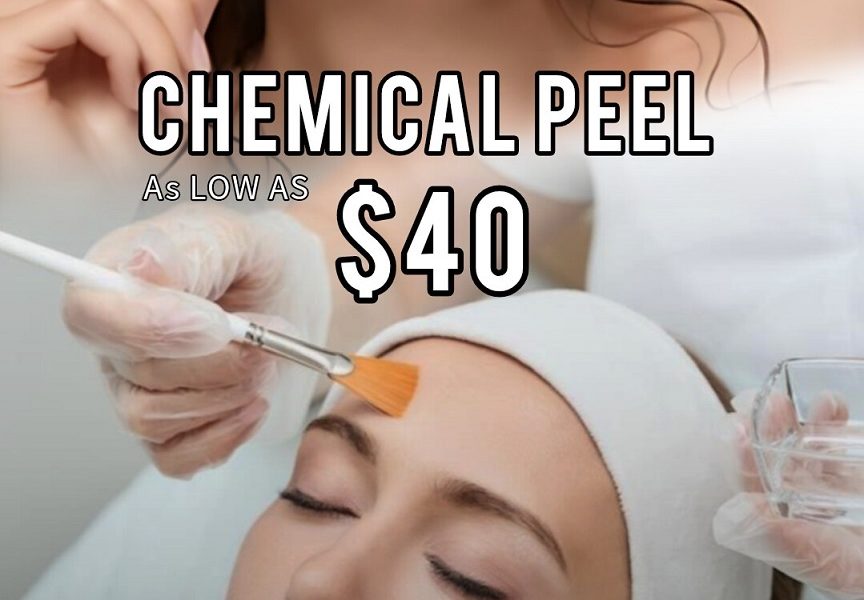Learn about the process, results, and why it’s a top choice for smoother, younger-looking skin.
1. Introduction
What is a Chemical Peel?
A chemical peel is a skin-resurfacing procedure that uses a specially formulated solution of acids to exfoliate the outermost layers of the skin. By removing damaged skin cells, chemical peels reveal healthier, smoother, and more youthful-looking skin underneath. The treatment is ideal for those looking to treat acne scars, hyperpigmentation, fine lines, and uneven skin texture.
Overview of Sherry’s Expertise in Chemical Peels
Sherry Cosmetic is renowned for her expertise in delivering safe and effective chemical peels tailored to the unique needs of each client. With years of experience in advanced skincare treatments, Sherry specializes in using the latest peel techniques to rejuvenate skin and give her clients a glowing, refreshed complexion.
Why Choose a Chemical Peel with Sherry?
Choosing a chemical peel with Sherry Cosmetic means receiving personalized care from a seasoned professional. Sherry’s approach is tailored to each individual’s skin type, concerns, and desired outcomes, ensuring that her clients leave with radiant and revitalized skin.
2. Types of Chemical Peels
Superficial Peels
Superficial peels are the mildest form of chemical peels, often referred to as “lunchtime peels.” These peels use alpha-hydroxy acids (AHAs) or beta-hydroxy acids (BHAs) to gently exfoliate the outer layer of skin. They are perfect for addressing minor imperfections, such as dullness, fine lines, and mild acne.
Medium Peels
Medium-depth peels penetrate the middle layers of skin using trichloroacetic acid (TCA) or glycolic acid. These peels are effective in treating more significant issues like acne scars, deeper wrinkles, and uneven skin tone. Recovery time is longer compared to superficial peels, but the results are more dramatic.
Deep Peels
Deep peels are the most intense type of chemical peel and use phenol or high concentrations of TCA to deeply penetrate the skin. These peels are ideal for severe wrinkles, deep scars, and extensive sun damage. Due to their strength, deep peels require a longer recovery time but produce long-lasting, transformative results.
3. How Chemical Peels Work
Understanding the Layers of Skin
The skin consists of three layers: the epidermis, dermis, and subcutaneous tissue. Chemical peels primarily target the epidermis and sometimes the upper dermis to remove dead skin cells and stimulate new skin cell growth.
How Acids in Chemical Peels Exfoliate and Rejuvenate the Skin
Acids like glycolic, salicylic, and lactic acid work by loosening the bonds between dead skin cells, allowing them to shed more easily. This process speeds up cell turnover, resulting in smoother, clearer skin with fewer imperfections.
4. Pre-Treatment Process
Consultation at Sherry Cosmetics
Before undergoing a chemical peel, Sherry Cosmetic provides a thorough consultation to assess your skin type, concerns, and goals. This personalized evaluation ensures that the chosen peel is safe and effective for your unique skin.
Skin Analysis
Sherry Cosmetic uses advanced skin analysis tools to understand your skin’s current condition, which helps in customizing the treatment. By analyzing factors such as oil production, pigmentation, and hydration levels, she ensures that the peel will target your specific concerns.
Preparation for a Chemical Peel
Prior to the procedure, Sherry Cosmetic will advise on how to prepare your skin, such as avoiding certain skincare products and treatments like retinoids or waxing. Pre-treatment care helps reduce the risk of irritation and maximizes the peel’s effectiveness.
5. The Chemical Peel Procedure
What Happens During a Chemical Peel?
The procedure begins with a thorough cleansing of the skin. Sherry Cosmetic then applies the chemical solution evenly across the treatment area, allowing it to penetrate the skin for a specific duration, depending on the type of peel.
The Application Process
The chemical solution may cause a mild tingling or stinging sensation as it works to exfoliate the skin. Sherry carefully monitors the skin’s response to the solution and may apply neutralizers or cooling agents to soothe the treated area.
The Duration of the Treatment
A chemical peel typically takes 30 to 60 minutes, depending on the depth of the peel and the area being treated.
6. Post-Treatment Care
Immediate Aftercare
After the peel, your skin may be red and feel tight or sensitive. Sherry Cosmetic will recommend specific products to calm and protect the skin, including gentle cleansers and hydrating moisturizers.
Recommended Skin Care Products Post-Peel
It’s crucial to use sunscreen with a high SPF and avoid direct sun exposure for several weeks after a peel, as the skin will be more sensitive to UV rays. Sherry’s post-treatment care plan includes products designed to hydrate and protect the skin during recovery.
Managing Redness and Sensitivity
Redness and peeling are common after a chemical peel, especially with medium and deep peels. Sherry Cosmetic will provide tips on managing these side effects, including applying soothing balms and avoiding picking or peeling the skin.
https://sherrycosmetics.ca/ +1 647 685 1213 Chemical Peel

